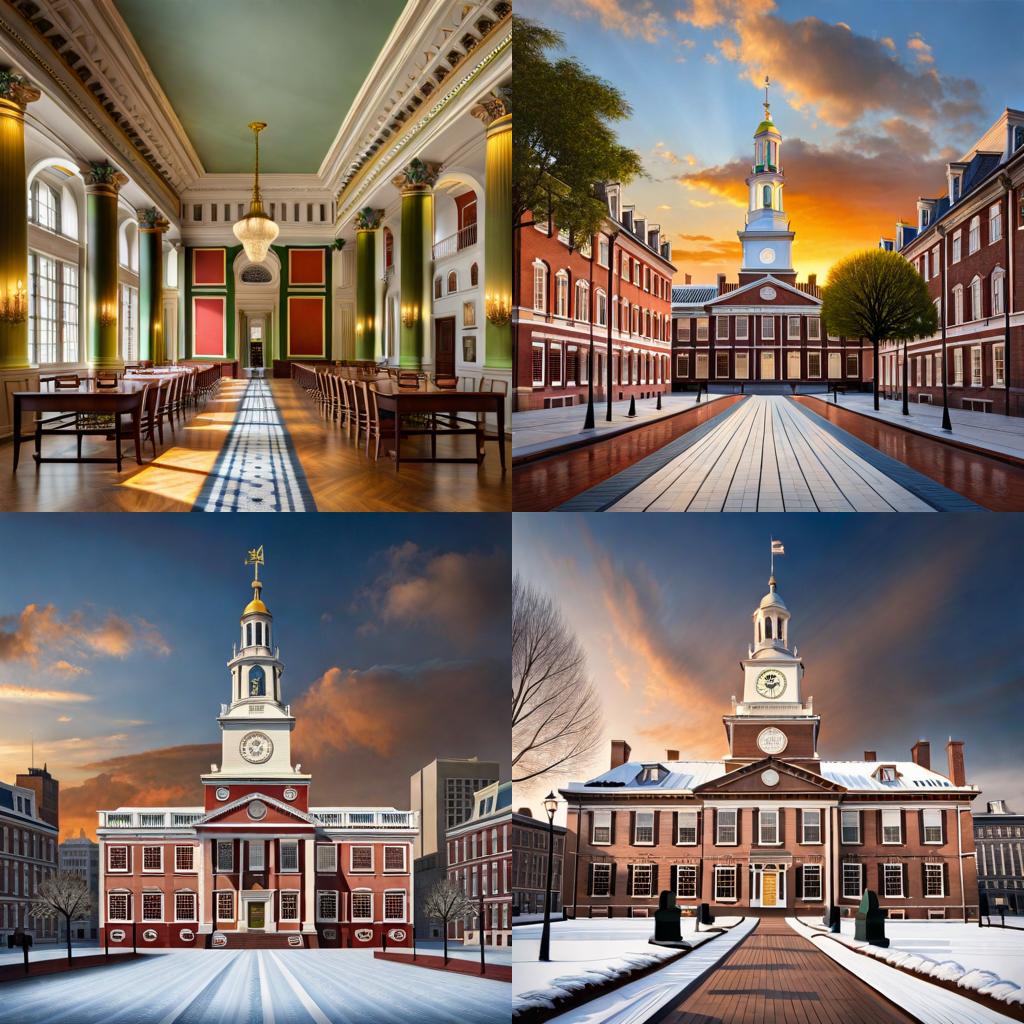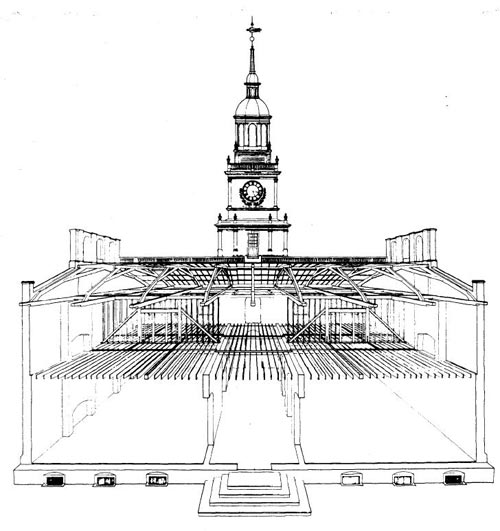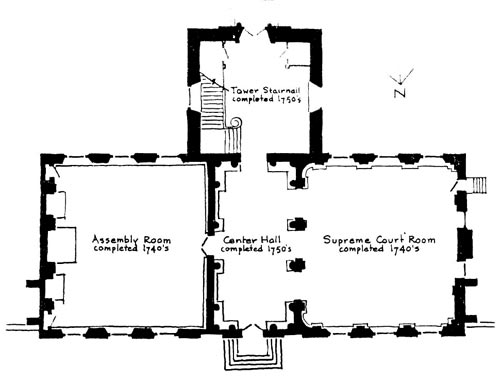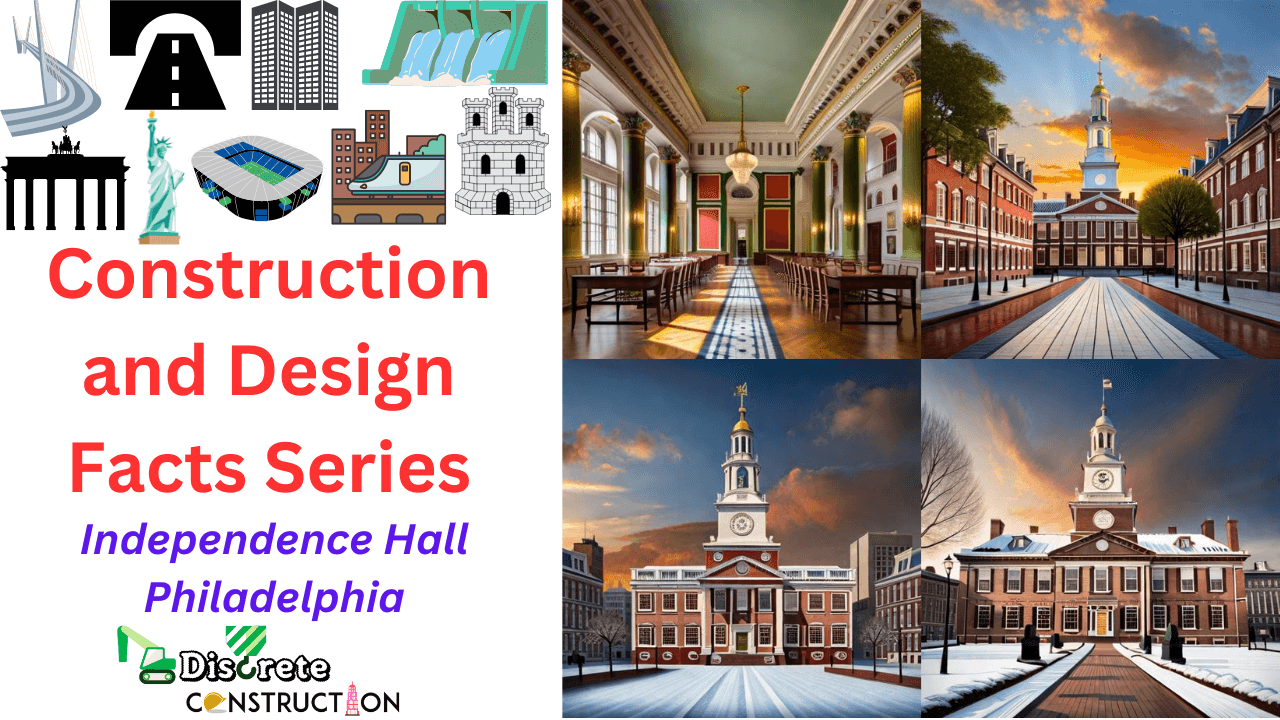Nestled in the heart of Philadelphia, Pennsylvania, stands the grand, historic monument that is Independence Hall. Synonymous with the birth of American freedom and democracy, this building tells a rich, fascinating story not only through its history but also its construction and design. This article unveils the top 50 construction and design facts about this venerable structure, bringing to life the incredible technical and architectural feats that made this symbol of American independence what it is today.
With its Georgian architectural style and robust brick structure, Independence Hall paints a vivid picture of the 18th-century colonial America. Behind this unassuming façade lies a remarkable chronicle of engineering ingenuity, practical design, and resourceful use of local materials that have withstood the test of time and etched the hall into the annals of American architecture.
The hall’s design and construction are a testament to the simplistic, yet practical approach adopted by the Quakers. Designed by Edmund Woolley and entrepreneur Andrew Hamilton, the Hall was initially built to house the State House of the Colony of Pennsylvania. Unbeknownst to them, the building they were constructing would become the crucible of American independence and the pivot around which the nation’s history would revolve.
Constructed predominantly from red bricks crafted in the traditional Flemish bond pattern, the hall was one of the largest buildings in colonial America, a testament to the architectural prowess of the era. The building measures 105 feet long on the front and 90 feet deep, with a wooden shingled roof adding to its colonial charm. The structural foundation, though not documented in modern engineering terms, has proven robust enough to endure for more than 270 years.

One of the architectural highlights of Independence Hall is its bell tower, an iconic feature that initially housed the famed Liberty Bell and served as the original clock tower for the city. This bell tower is central to the narrative of Independence Hall’s construction, emphasizing the historical significance and the inherent engineering challenges faced during its construction and subsequent restorations.
From the elegant Doric columns framing the entrance to the Assembly Room, which witnessed the signing of the Declaration of Independence and U.S. Constitution, every corner of the hall echoes the design philosophies of the Georgian era and the rich tapestry of American history.
Interestingly, the Hall’s construction wasn’t without challenges. The original steeple had to be removed due to structural concerns, and the Liberty Bell was relocated for fear that its weight might compromise the building’s integrity. These anecdotes offer an insightful perspective into the construction hurdles that had to be overcome, painting a detailed picture of the thought and care that went into maintaining the hall’s structural stability.

Despite being built in an era before the establishment of modern construction codes and practices, Independence Hall showcases the practical wisdom and intuitive engineering prowess of its builders. They relied on architectural conventions of the time and the durability of local materials, resulting in a building that not only served its immediate purpose but also endured the changing sands of time.
The story of Independence Hall is as much about its design and construction as it is about the historical events it hosted. Whether it’s serving as a courthouse, hosting the Second Continental Congress, or acting as a safe house for the U.S. Constitution and the Declaration of Independence during the War of 1812, the hall’s architectural adaptability to serve various purposes is a testament to its pragmatic design and robust construction.
The exploration of Independence Hall’s construction and design, however, would be incomplete without acknowledging its vital role as a tourism hotspot and its profound economic impact. With over a million visitors each year, Independence Hall is more than just a historical monument; it’s an engine that powers the local economy, underscoring the lasting significance of well-preserved, historical structures.

In the forthcoming sections, we delve into the intriguing details of Independence Hall’s construction and design, shedding light on the 50 most fascinating aspects of this iconic structure. Whether you’re an architecture enthusiast, a history buff, or a curious reader, this article promises a captivating journey into the heart of American architectural history.
Top-50 Facts of Independence Hall, Philadelphia
- Independence Hall is located in Philadelphia, Pennsylvania, USA.
- The construction started in 1732 and completed in 1753.
- It’s known as the birthplace of the United States, as the Declaration of Independence and U.S. Constitution were both debated and signed within its walls.
- It was originally built to be the State House of the Colony of Pennsylvania.
- The architect of the building was Edmund Woolley, and the entrepreneur was Andrew Hamilton.
- Independence Hall is a two-story building, with a simple yet elegant design.
- The bell tower, which houses the Liberty Bell, was the original “clock tower” for the city.
- The building was made of brick and measures 105 feet long on the front and 90 feet deep.
- The walls of the building are red bricks, crafted in the traditional Flemish bond pattern.
- The bricks used in construction were made locally, using the abundant clay found in the area.
- The tower at the center of the building was designed to hold a public clock.
- Its architectural style is Georgian, which emphasizes symmetry and balance.
- Originally, there was a steeple, but it was taken down due to structural problems.
- The building has a wooden shingled roof.
- The building’s design focuses on practicality and simplicity, in line with Quaker ideals.
- The first floor has courtrooms used by the Pennsylvania Supreme Court.
- The second floor holds the Assembly Room, where the Declaration of Independence and U.S. Constitution were signed.
- The Assembly Room is preserved in its original design and furniture layout.
- The cost of construction was around 400 pounds, which today would be over $100,000.
- The entrance to the hall is framed by Doric columns.
- The central bell tower, which was added later, has become one of the most iconic parts of the building.
- The Liberty Bell was commissioned in 1751 and was first housed in the steeple of the State House.
- The bell was moved out of the building after the city officials feared that the weight might cause the structure to collapse.
- The exact type of soil on which the building was constructed is unknown due to the lack of geotechnical investigations in the 18th century. It’s likely local Philadelphia soil, which is typically sandy with some clay.
- It was one of the largest buildings in colonial America.
- It served as the meeting place for the Second Continental Congress.
- The hall was restored in the late 19th and early 20th centuries.
- It was designated a World Heritage Site in 1979.
- During the Revolutionary War, the hall served as a hospital for the Continental Army.
- The building’s structural integrity has allowed it to withstand over 270 years of history, although it underwent numerous restorations.
- The building’s life span has far exceeded that of typical structures due to constant maintenance and several renovations.
- The Hall is part of the larger Independence National Historical Park in Philadelphia.
- The economic impact of Independence Hall is significant due to its historic importance and attraction as a tourist site.
- Given its construction era, the concept of “code” for design didn’t exist when Independence Hall was built. The design was based on architectural practices of the time.
- Modern preservation standards are applied to the building to maintain its structural integrity and historical authenticity.
- Independence Hall has played host to numerous important historical events, including the vote for the Declaration of Independence on July 2, 1776.
- The hall was used for many purposes over the years, including as a courthouse for the U.S. District Court.
- The original color of the hall is said to have been a “pale cream color.”
- The hall features a wooden clock dial on the northern facade of the tower.
- During the British occupation of Philadelphia, the hall was used as a barracks for troops and a hospital.
- The hall has undergone several restorations, including one in 1830 and another in the 1890s.
- The wings and arcades of the building were not part of the original design; they were added later.
- Independence Hall has been featured on U.S. currency, including the $100 bill.
- The building has been depicted in various forms of media and pop culture, including films, TV shows, and books.
- The Liberty Bell, housed in the steeple of the hall, has become a symbol of American independence.
- The hall was the site of Abraham Lincoln’s body lying in repose after his assassination in 1865.
- The hall is open for public tours, which are conducted by the National Park Service.
- The building’s Georgian architectural style was popular among the English colonies in the 18th century.
- In the late 20th century, the hall was equipped with modern facilities, such as heating, cooling, and fire protection systems, to preserve the structure and its artifacts.
- It is said that both the U.S. Constitution and the Declaration of Independence were stored in the hall during the War of 1812 to protect them from British forces.

Read More
When was Independence Hall in Philadelphia built?
The construction of Independence Hall began in 1732 and was completed in 1753. It was designed to serve as the State House of the Colony of Pennsylvania.
Who designed and constructed Independence Hall?
The architect of Independence Hall was Edmund Woolley, and the entrepreneur responsible for its construction was Andrew Hamilton.
What architectural style is Independence Hall?
Independence Hall is designed in the Georgian architectural style, which was popular during the 18th century. This style is characterized by its symmetry, balance, and simplicity.
What materials were used in the construction of Independence Hall?
Independence Hall was constructed mainly from locally made red bricks, created in the traditional Flemish bond pattern. The roof was composed of wooden shingles.
Why is Independence Hall significant?
Independence Hall is significant because it is the site where the U.S. Declaration of Independence and the U.S. Constitution were debated and signed. It is considered the birthplace of American democracy.
How has Independence Hall been preserved?
Independence Hall has undergone numerous restorations to preserve its historical authenticity and structural integrity. Modern facilities such as heating, cooling, and fire protection systems have been added to aid in preservation.
What are the unique features of Independence Hall’s design?
Some unique features of Independence Hall include its central bell tower, which originally housed the Liberty Bell, the use of Doric columns at the entrance, and the Assembly Room, which maintains its original design and furniture layout.
What were the challenges in constructing Independence Hall?
The construction of Independence Hall saw several challenges, including structural issues with the original steeple, which had to be removed, and concerns about the weight of the Liberty Bell causing potential damage to the building.
How large is Independence Hall?
Independence Hall measures 105 feet long at the front and 90 feet deep, making it one of the largest buildings in colonial America.
How has the design of Independence Hall influenced American architecture?
Independence Hall has had a significant influence on American architecture. Its Georgian style, characterized by symmetry and balance, set a precedent for public buildings in the years that followed. Its combination of elegance and functionality continues to be admired and replicated in modern designs.
is independence hall Philadelphia open to the public ?
Yes, Independence Hall in Philadelphia is open to the public.
is the entry to independence Philadelphia hall free ?
The entry to Independence Hall in Philadelphia is free, but timed entry tickets are required.
what are the opening hours of independence hall Philadelphia ?
The opening hours of Independence Hall in Philadelphia vary depending on the season. Generally, it is open from 9:00 AM to 5:00 PM.
where to park near independence hall Philadelphia ?
There are several parking options near Independence Hall in Philadelphia. Some nearby parking garages and lots include the Independence Visitor Center Parking Garage, the Bourse Garage, and the AutoPark at Independence Mall. Street parking is also available but limited.
where is independence hall Philadelphia located ?
Independence Hall in Philadelphia is located at 520 Chestnut Street, Philadelphia, PA 19106, in the heart of the city’s Historic District.
Read More

